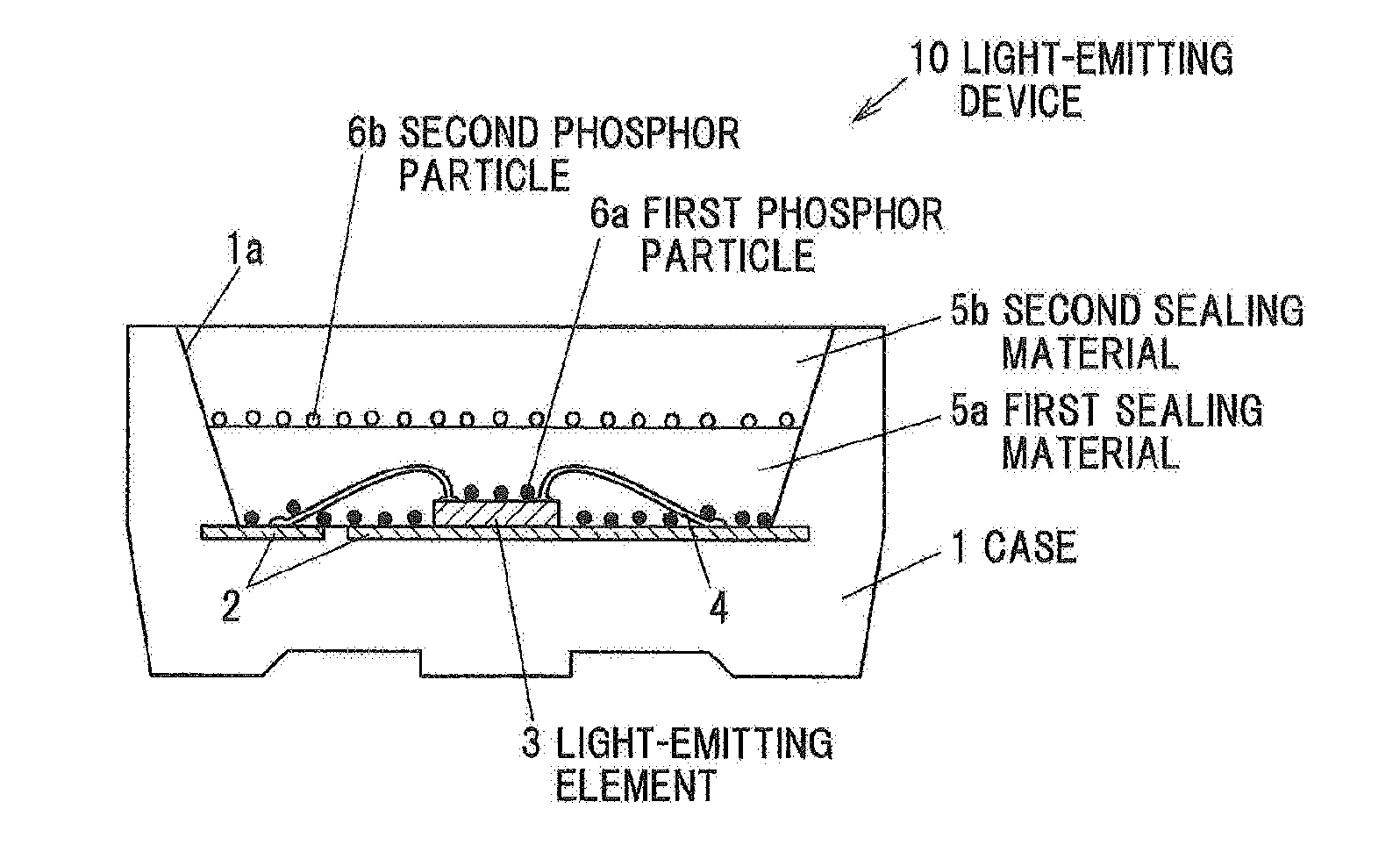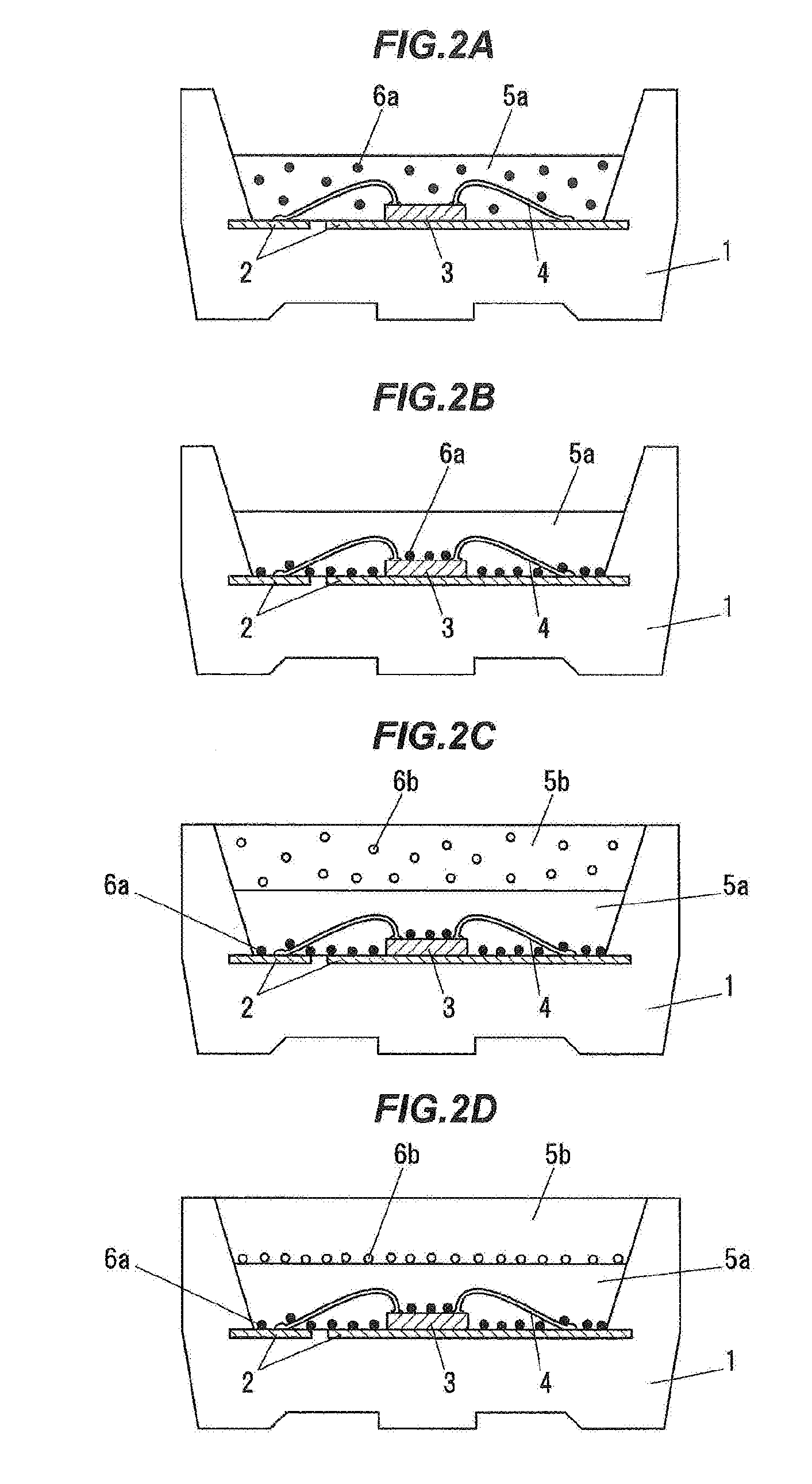Method of manufacturing light-emitting device
a technology of light-emitting devices and manufacturing methods, which is applied in the direction of solid-state devices, electric lighting sources, electric light sources, etc., can solve the problems of uneven emission color of light-emitting devices, and achieve the effect of reducing uneven emission color
- Summary
- Abstract
- Description
- Claims
- Application Information
AI Technical Summary
Benefits of technology
Problems solved by technology
Method used
Image
Examples
first embodiment
Configuration of Light-Emitting Device
[0029]FIG. 1A is a perspective view showing a light-emitting device 10 in the first embodiment. The light-emitting device 10 has a case 1 having a recessed portion 1a, a base 2 housed in the case 1 so that an upper surface is exposed on the bottom of the recessed portion 1a, a light-emitting element 3 mounted on the base 2, a first sealing material 5a and a second sealing material 5b filled in the recessed portion 1a to seal the light-emitting element 3, and first phosphor particles 6a and second phosphor particles 6b respectively included in the first sealing material 5a and the second sealing material 5b.
[0030]The case 1 is formed of, e.g., a thermoplastic resin such as polyphthalamide resin, LCP (liquid crystal polymer) or PCT (polycyclohexylene dimethylene terephalate), or a thermosetting resin such as silicone resin, modified silicone resin, epoxy resin or modified epoxy resin. The case 1 may include light-reflecting particles of titanium d...
second embodiment
Configuration of Light-Emitting Device
[0048]FIG. 3 is a vertical cross sectional view showing a light-emitting device 20 in the second embodiment. The light-emitting device 20 is different from the light-emitting device 10 of the first embodiment mainly in that a first sealing material 25a including a dispersant is provided and the first phosphor particles 6a in the first sealing material 25a hardly precipitate. Note that, the explanation of the same features as the light-emitting device 10 in the first embodiment will be omitted or simplified.
[0049]The first sealing material 25a includes a dispersant for improving dispersibility of the first phosphor particles 6a The dispersant is, e.g., particles of silica such as AEROSIL™.
[0050]The base material of the first sealing material 25a can be the same material as the first sealing material 5a in the first embodiment but is particularly preferably an organically modified silicone. Since the viscosity of the organically modified silicone ...
third embodiment
Configuration of Light-Emitting Device
[0059]FIG. 5 is a vertical cross sectional view showing a light-emitting device 30 in the third embodiment. The light-emitting device 30 is different from the light-emitting device 10 of the first embodiment mainly in that at least some of the second phosphor particles 6b precipitate in the first sealing material 5a. Note that, the explanation of the same features as the light-emitting device 10 in the first embodiment will be omitted or simplified.
[0060]In the light-emitting device 30, relatively large particles (particles having a particle size of at least more than D50, preferably not less than D90) of the first phosphor particles 6a precipitate close to the bottom of the first sealing material 5a, and at least some of relatively large particles (particles having a particle size of at least more than D50, preferably not less than D90) of the second phosphor particles 6b precipitate in the first sealing material 5a.
[0061]FIG. 5 shows a state ...
PUM
 Login to View More
Login to View More Abstract
Description
Claims
Application Information
 Login to View More
Login to View More - R&D
- Intellectual Property
- Life Sciences
- Materials
- Tech Scout
- Unparalleled Data Quality
- Higher Quality Content
- 60% Fewer Hallucinations
Browse by: Latest US Patents, China's latest patents, Technical Efficacy Thesaurus, Application Domain, Technology Topic, Popular Technical Reports.
© 2025 PatSnap. All rights reserved.Legal|Privacy policy|Modern Slavery Act Transparency Statement|Sitemap|About US| Contact US: help@patsnap.com



